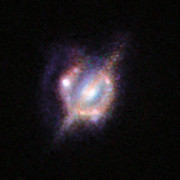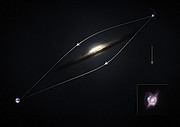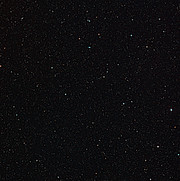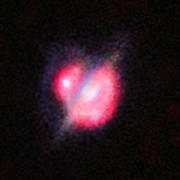Persbericht
Beste beeld tot nu toe van twee botsende sterrenstelsels in het verre heelal
ALMA past Sherlock Holmes-methode toe
26 augustus 2014
Een internationaal team van astronomen heeft met de Atacama Large Millimeter/submillimeter Array (ALMA) en andere telescopen op aarde en in de ruimte de beste opname ooit gemaakt van een botsing tussen twee sterrenstelsels tot op heden. De botsing vond plaats toen het universum nog maar half zo oud was als nu. Door een vergrootglas ter grootte van een sterrenstelsel konden ze details zien die anders onzichtbaar zouden zijn gebleven. Uit dit nieuwe onderzoek naar het sterrenstelsel H-ATLAS J142935.3-002836 blijkt dat dit complexe, verafgelegen object lijkt op de bekende nabije botsing van sterrenstelsels, de Antennestelsels.
De beroemde, fictieve detective Sherlock Holmes gebruikte een vergrootglas om bijna onzichtbaar maar belangrijk bewijs te vinden. Astronomen gebruiken meerdere telescopen op aarde en in de ruimte [1], en een enorme kosmische lens om extreme sterformatie in het jonge universum te onderzoeken.
"Astronomen worden vaak beperkt in hun onderzoek door de mogelijkheden van hun telescopen, maar in sommige gevallen kunnen ze toch details zien met natuurlijke lenzen die door het universum zijn gemaakt", legt eerste auteur Hugo Messias van de Universidad de Concepción (Chile) en het Centro de Astronomia e Astrofísica da Universidade de Lisboa (Portugal) uit. "Einstein voorspelde in zijn algemene relativiteitstheorie dat licht zich niet in een rechte lijn voortplant, maar wordt afgebogen als er genoeg materie aanwezig is. Het effect is vergelijkbaar met de afbuiging van licht door een normale lens."
Deze kosmische lenzen ontstaan door zware structuren zoals sterrenstelsel en clusters van sterrenstelsels die licht van achterliggende objecten afbuigen met hun zwaartekracht - het effect wordt een zwaartekrachtslens genoemd. Door de versterkende eigenschappen van dit effect kunnen astronomen objecten bestuderen die anders onzichtbaar zouden zijn, en kunnen ze lokale sterrenstelsels vergelijken met verafgelegen sterrenstelsels in het jonge universum.
Deze zwaartekrachtslenzen werken alleen als het lenzende sterrenstelsel en het sterrenstelsel dat er ver achter ligt precies op een lijn staan.
"Deze perfecte opstellingen zijn zeldzaam en moeilijk te vinden", voegt Hugo Messias toe, "maar uit recente onderzoeken blijkt dat we veel efficiënter naar hen kunnen zoeken door waarnemingen te doen op ver-infrarood- en millimetergolflengten."
H-ATLAS J142935.3-00283 (of kortweg H1429-0028) is een object dat is gevonden in de Herschel Astrophysical Terahertz Large Area Survey (H-ATLAS). Het sterrenstelsel is nauwelijks te zien in zichtbaar licht, maar is een van de helderste, in het ver-infrarooddeel van het spectrum gelensde objecten die we tot nu toe hebben gevonden. We zien H1429-0028 in de tijd dat het heelal half zo oud was als nu.
Het internationale team heeft uitgebreide vervolgwaarnemingen gedaan met de beste telescopen op aarde en in de ruimte, waaronder de NASA/ESA Hubble Space Telescope, ALMA, het Keck Observatorium, de Karl Jansky Very Large Array (JVLA) en andere, omdat het onderzoek werd uitgevoerd op de grens van wat mogelijk is. De telescopen boden verschillende blikken op het ongewone object wat de beste inzichten in zijn eigenschappen opleverden.
De Hubble- en Keck-foto’s legden een gedetailleerde zwaartekrachtslens bloot - een ring van licht rondom het voorste sterrenstelsel. Uit de hoge-resolutiefoto’s bleek dat we dit schijfstelsel - dat op onze Melkweg lijkt - van de zijkant zien. Het sterrenstelsel blokkeert achtergrondlicht door zijn grote stofwolken.
Deze verduistering is geen probleem voor ALMA en de JVLA aangezien beide faciliteiten op langere golflengten waarnemen. Op deze golflengten heeft stof geen effect. Door de gegevens te combineren ontdekte het team dat het systeem op de achtergrond twee botsende sterrenstelsels zijn. Vanaf dat moment speelden ALMA en de JVLA een sleutelrol bij de bepaling van de eigenschappen van dit object.
Met ALMA werd het koolmonoxide getraceerd waardoor het mogelijk is om stervorming in sterrenstelsels te onderzoeken. De ALMA-waarnemingen maakten het ook mogelijk om de beweging van de materie in het verafgelegen object te meten. Dit was essentieel om aan te tonen dat het gelensde object inderdaad een aanhoudende botsing van sterrenstelsels is waarbij per jaar honderden nieuwe sterren ontstaan, en dat een van de sterrenstelsels nog steeds tekenen van rotatie vertoont; een indicatie dat het een schijfstelsel was.
Dit systeem van twee botsende sterrenstelsels lijkt op een object dat veel dichter bij ons staat: de Antennestelsels. Dit is een spectaculaire botsing tussen twee sterrrenstelsels die vroeger waarschijnlijk een schrijfstructuur hadden. In de Antennestelsels ontstaan sterren van in totaal slechts een paar zonsmassa’s per jaar, terwijl in H1429-0028 jaarlijks meer dan 400 zonsmassa’s aan gas wordt omgezet in sterren.
Rob Ivison, ESO’s Director of Science en coauteur van het artikel concludeert: "Met ALMA was het mogelijk om dit raadsel op te lossen omdat we informatie hadden over de snelheid van het gas in de sterrenstelsels. Wij konden de verschillende componenten van het object onderscheiden, waaruit duidelijk bleek dat dit een botsing van sterrenstelsels is. In dit prachtige onderzoek zijn twee botsende sterrenstelsels op heterdaad betrapt terwijl ze extreme sterformatie aanzwengelden."
Noten
[1] Tot het brede scala aan faciliteiten die zijn gebruikt om waarnemingen te doen die nodig waren om dit mysterie te ontrafelen behoren drie ESO-telescopen - ALMA, APEX en VISTA. De andere telescopen en surveys die zijn gebruikt om deze waarnemingen te ondersteunen zijn: de NASA/ESA Hubble Space Telescope, de Gemini South telescope, de Keck-II telescope, de NASA Spitzer Space Telescope, de Jansky Very Large Array, CARMA, IRAM en SDSS en WISE.
Meer informatie
De Atacama Large Millimeter/submillimeter Array (ALMA), een internationale astronomische faciliteit, is een samenwerkingsverband van Europa, Noord-Amerika en Oost-Azië, met steun van de republiek Chili. ALMA wordt in Europa gefinancierd door de Europese Zuidelijke Sterrenwacht (ESO), in Noord-Amerika door de National Science Foundation (NSF) van de VS in samenwerking met de National Research Council van Canada (NRC) en de National Science Council van Taiwan (NSC), en in Oost-Azië door de National Institutes of Natural Sciences (NINS) van Japan in samenwerking met de Academia Sinica (AS) in Taiwan. De bouw en het beheer van ALMA worden namens Europa geleid door ESO, namens Noord-Amerika door het National Radio Astronomy Observatory (NRAO), dat bestuurd wordt door de Associated Universities, Inc. (AUI), en namens Oost-Azië door het National Astronomical Observatory of Japan (NAOJ). De overkoepelende leiding en het toezicht op bouw, ingebruikname en beheer van ALMA is in handen van het Joint ALMA Observatory (JAO).
Het onderzoek is gepresenteerd in het artikel 'Herschel-ATLAS and ALMA HATLAS J142935.3-002836, a lensed major merger at redshift 1.027', door Hugo Messias et al., dat op 26 augustus 2014 online zal verschijnen in het tijdschrift Astronomy & Astrophysics.
Het team bestaat uit Hugo Messias (Universidad de Concepción, Barrio Universitario, Chile; Centro de Astronomia e Astrofísica da Universidade de Lisboa, Portugal), Simon Dye (School of Physics and Astronomy, University of Nottingham, UK), Neil Nagar (Universidad de Concepción, Barrio Universitario, Chile), Gustavo Orellana (Universidad de Concepción, Barrio Universitario, Chile), R. Shane Bussmann (Harvard-Smithsonian Center for Astrophysics, USA), Jae Calanog (Department of Physics & Astronomy, University of California, USA), Helmut Dannerbauer (Universität Wien, Institut für Astrophysik, Austria), Hai Fu (Astronomy Department, California Institute of Technology, USA), Edo Ibar (Pontificia Universidad Católica de Chile, Departamento de Astronomía y Astrofísica, Chile), Andrew Inohara (Department of Physics & Astronomy, University of California, USA), R. J. Ivison (Institute for Astronomy, University of Edinburgh, Royal Observatory, UK; ESO, Garching, Germany), Mattia Negrello (INAF, Osservatorio Astronomico di Padova, Italy), Dominik A. Riechers (Astronomy Department, California Institute of Technology, USA; Department of Astronomy, Cornell University, USA), Yun-Kyeong Sheen (Universidad de Concepción, Barrio Universitario, Chile), Simon Amber (The Open University, Milton Keynes, UK), Mark Birkinshaw (H. H. Wills Physics Laboratory, University of Bristol, UK; Harvard-Smithsonian Center for Astrophysics, USA), Nathan Bourne (School of Physics and Astronomy, University of Nottingham, UK), Dave L. Clements (Astrophysics Group, Imperial College London, UK), Asantha Cooray (Department of Physics & Astronomy, University of California, USA; Astronomy Department, California Institute of Technology, USA), Gianfranco De Zotti (INAF, Osservatorio Astronomico di Padova, Italy), Ricardo Demarco (Universidad de Concepción, Barrio Universitario, Chile), Loretta Dunne (Department of Physics and Astronomy, University of Canterbury, New Zealand; Institute for Astronomy, University of Edinburgh, Royal Observatory, UK), Stephen Eales (School of Physics and Astronomy, Cardiff University,UK), Simone Fleuren (School of Mathematical Sciences, University of London, UK), Roxana E. Lupu (Department of Physics and Astronomy, University of Pennsylvania, USA), Steve J. Maddox (Department of Physics and Astronomy, University of Canterbury, New Zealand; Institute for Astronomy, University of Edinburgh, Royal Observatory, UK), Michał J. Michałowski (Institute for Astronomy, University of Edinburgh, Royal Observatory, UK), Alain Omont (Institut d’Astrophysique de Paris, UPMC Univ. Paris, France), Kate Rowlands (School of Physics & Astronomy, University of St Andrews, UK), Dan Smith (Centre for Astrophysics Research, Science & Technology Research Institute, University of Hertfordshire, UK), Matt Smith (School of Physics and Astronomy, Cardiff University,UK) en Elisabetta Valiante (School of Physics and Astronomy, Cardiff University, UK).
ESO is de belangrijkste intergouvernementele astronomische organisatie in Europa en de meest productieve sterrenwacht ter wereld. Zij wordt ondersteund door vijftien landen: België, Brazilië, Denemarken, Duitsland, Finland, Frankrijk, Italië, Nederland, Oostenrijk, Portugal, Spanje, Tsjechië, het Verenigd Koninkrijk, Zweden en Zwitserland. ESO voert een ambitieus programma uit, gericht op het ontwerpen, bouwen en beheren van grote sterrenwachten die astronomen in staat stellen om belangrijke wetenschappelijke ontdekkingen te doen. Ook speelt ESO een leidende rol bij het bevorderen en organiseren van samenwerking op astronomisch gebied. ESO beheert drie waarnemingslocaties van wereldklasse in Chili: La Silla, Paranal en Chajnantor. Op Paranal staan ESO’s Very Large Telescope (VLT), de meest geavanceerde optische sterrenwacht ter wereld, en twee surveytelescopen: VISTA werkt in het infrarood en is de grootste surveytelescoop ter wereld en de VLT Survey Telescope is de grootste telescoop die uitsluitend is ontworpen om de hemel in zichtbaar licht in kaart te brengen. ESO is ook de Europese partner van de revolutionaire telescoop ALMA, het grootste astronomische project van dit moment. Daarnaast bereidt ESO momenteel de bouw voor van de 39-meter Europese Extremely Large optical/near-infrared Telescope (E-ELT), die ‘het grootste oog op de hemel’ ter wereld zal worden.
Links
- Onderzoeksartikel
- Meer over ALMA
- Foto’s van ALMA
- Video’s van ALMA
- ALMA-brochure
- De ALMA-film - In search of our Cosmic Origins
- Het ALMA-fotoboek In search of our Cosmic Origins - De bouw van de Atacama Large Millimeter/submillimeter Array
- Meer persberichten met ALMA
Contact
Hugo Messias
Universidad de Concepción, Chile / Centro de Astronomia e Astrofísica da Universidade de Lisboa, Portugal
Tel: +351 21 361 67 47/30
E-mail: hmessias@oal.ul.pt
Richard Hook
ESO, Public Information Officer
Garching bei München, Germany
Tel: +49 89 3200 6655
Mobiel: +49 151 1537 3591
E-mail: rhook@eso.org
Marieke Baan (Perscontact Nederland)
ESO Science Outreach Network
en NOVA Informatie Centrum
Tel: +31(0)20-5257480
E-mail: eson-netherlands@eso.org
Over dit bericht
| Persberichten nr.: | eso1426nl |
| Naam: | H-ATLAS J142935.3-002836 |
| Type: | Early Universe : Galaxy : Type : Gravitationally Lensed |
| Facility: | Atacama Large Millimeter/submillimeter Array, Atacama Pathfinder Experiment, CARMA, Gemini Observatory, Hubble Space Telescope, Spitzer Space Telescope, Visible and Infrared Survey Telescope for Astronomy |
| Science data: | 2014A&A...568A..92M |
Our use of Cookies
We use cookies that are essential for accessing our websites and using our services. We also use cookies to analyse, measure and improve our websites’ performance, to enable content sharing via social media and to display media content hosted on third-party platforms.
ESO Cookies Policy
The European Organisation for Astronomical Research in the Southern Hemisphere (ESO) is the pre-eminent intergovernmental science and technology organisation in astronomy. It carries out an ambitious programme focused on the design, construction and operation of powerful ground-based observing facilities for astronomy.
This Cookies Policy is intended to provide clarity by outlining the cookies used on the ESO public websites, their functions, the options you have for controlling them, and the ways you can contact us for additional details.
What are cookies?
Cookies are small pieces of data stored on your device by websites you visit. They serve various purposes, such as remembering login credentials and preferences and enhance your browsing experience.
Categories of cookies we use
Essential cookies (always active): These cookies are strictly necessary for the proper functioning of our website. Without these cookies, the website cannot operate correctly, and certain services, such as logging in or accessing secure areas, may not be available; because they are essential for the website’s operation, they cannot be disabled.
Functional Cookies: These cookies enhance your browsing experience by enabling additional features and personalization, such as remembering your preferences and settings. While not strictly necessary for the website to function, they improve usability and convenience; these cookies are only placed if you provide your consent.
Analytics cookies: These cookies collect information about how visitors interact with our website, such as which pages are visited most often and how users navigate the site. This data helps us improve website performance, optimize content, and enhance the user experience; these cookies are only placed if you provide your consent. We use the following analytics cookies.
Matomo Cookies:
This website uses Matomo (formerly Piwik), an open source software which enables the statistical analysis of website visits. Matomo uses cookies (text files) which are saved on your computer and which allow us to analyze how you use our website. The website user information generated by the cookies will only be saved on the servers of our IT Department. We use this information to analyze www.eso.org visits and to prepare reports on website activities. These data will not be disclosed to third parties.
On behalf of ESO, Matomo will use this information for the purpose of evaluating your use of the website, compiling reports on website activity and providing other services relating to website activity and internet usage.
Matomo cookies settings:
Additional Third-party cookies on ESO websites: some of our pages display content from external providers, e.g. YouTube.
Such third-party services are outside of ESO control and may, at any time, change their terms of service, use of cookies, etc.
YouTube: Some videos on the ESO website are embedded from ESO’s official YouTube channel. We have enabled YouTube’s privacy-enhanced mode, meaning that no cookies are set unless the user actively clicks on the video to play it. Additionally, in this mode, YouTube does not store any personally identifiable cookie data for embedded video playbacks. For more details, please refer to YouTube’s embedding videos information page.
Cookies can also be classified based on the following elements.
Regarding the domain, there are:
- First-party cookies, set by the website you are currently visiting. They are stored by the same domain that you are browsing and are used to enhance your experience on that site;
- Third-party cookies, set by a domain other than the one you are currently visiting.
As for their duration, cookies can be:
- Browser-session cookies, which are deleted when the user closes the browser;
- Stored cookies, which stay on the user's device for a predetermined period of time.
How to manage cookies
Cookie settings: You can modify your cookie choices for the ESO webpages at any time by clicking on the link Cookie settings at the bottom of any page.
In your browser: If you wish to delete cookies or instruct your browser to delete or block cookies by default, please visit the help pages of your browser:
Please be aware that if you delete or decline cookies, certain functionalities of our website may be not be available and your browsing experience may be affected.
You can set most browsers to prevent any cookies being placed on your device, but you may then have to manually adjust some preferences every time you visit a site/page. And some services and functionalities may not work properly at all (e.g. profile logging-in, shop check out).
Updates to the ESO Cookies Policy
The ESO Cookies Policy may be subject to future updates, which will be made available on this page.
Additional information
For any queries related to cookies, please contact: pdprATesoDOTorg.
As ESO public webpages are managed by our Department of Communication, your questions will be dealt with the support of the said Department.







